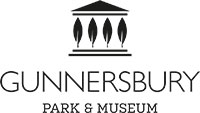In this blog series, we'll be interviewing some familiar faces around Gunnersbury. Next up is our maternity cover curator Amy Dobson
Amy Dobson is maternity cover curator at Gunnersbury Park Museum. She has a life long love of museums and grew up in Fife in Scotland but started volunteering at the museum #fortheloveofgunnersbury before landing her current role
What did you do before you came to Gunnersbury?
I graduated from Glasgow University with a degree in economic and social history and I started as a volunteer room guide at the Tenement House, which is a historic house museum in Glasgow. I then got a job as a property assistant, looking after the artefacts and doing conservation work. There were just four members of staff so we ended up doing everything – and that gave me great all round experience. I’ve always loved museums. I remember having my seventh birthday party in one. I grew up in Inverkeithing in Fife which is a royal burgh with rich medieval history that I always found so fascinating.
How did you hear about Gunnersbury?
I met a colleague from Gunnersbury at a museums conference and we just got chatting. I said that I was moving to London and she suggested that I come in and talk to her. I actually started travelling down from Scotland to volunteer here and then when the job of curatorial assistant came up I applied for it and got it. I think they could see how enthusiastic I was!
When did you start work here?
I started at Gunnersbury Park Museum at the beginning of 2017 so I was working during the final stages of the redevelopment and preparing the museum for reopening. One of my tasks was to organise and manage the installation of objects throughout the museum, the most challenging being the Four Seasons ceiling painting in the Long Gallery. We had two scaffolding towers and around eight people working on it. It took a lot of coordination. My job was to stand there and say: “A little bit to the left, no, a little bit to the right.”
How do you choose what to display and how to display it?
The museum galleries take a thematic approach, looking at important aspects of local history such as Industry, Leisure and Home and bringing them to life. There’s quite a strong theme of migration in the museum, especially in our People & Place gallery because that’s a very important part of our local history. People have been coming to this area of the country to live and work for thousands of years.
Which subjects in particular do you cover?
We look at all areas of social history throughout Ealing and Hounslow. We have a particularly strong collection relating to the area’s industrial history. For example, Acton was famous for its laundries. It was known as “Soap Sud Island,” because the water in this stretch of the Thames was softer than in other places and so it was better for washing clothes in. We also celebrate theatre, fashion and sports, including the role of Brentford Football Club. The history and culture here is so rich and diverse. I love the fact that you’re in zone three of the tube and you’re somewhere that’s so peaceful and idyllic. I often wander around the park in my lunch break.


Do people ever offer you objects?
Yes, sometimes we have people who find something unusual when they’re clearing out an elderly relative’s home and they bring it in to us. That’s one of the great things about being a local museum. Each object has to be researched and considered as to how it would fit in with the collection. We have to have a strict collections policy otherwise we’d be inundated. We’re currently looking to collect objects, journals or memories from life during lockdown to build a picture of how the local area has had to change and adapt over the last few months.
What have you accepted recently?
We recently acquired an Aladdin blue flame heater. The donor said that he remembered the strong smell of it and watching the blue flame when he was a boy. It was in good condition and is relevant to our collection as the Aladdin factory who manufactured them was based in Greenford. It will soon be displayed in our Industry Gallery and it’s lovely that it comes from a local family home.
Gunnersbury itself was a family home, wasn’t it?
Yes, it was the Rothschilds’ country estate. But it also had working gardens and farms. There were orchards and glass houses with pineapples and exotic fruit which would have been incredible luxuries in those days. There was also an ice house where ice would have been stored deep underground and then brought inside to keep cabinets for meat and dairy cold. There have been many other residents of the Gunnersbury Estate over the years including Princess Amelia, supposed favourite daughter of King George II.
What plans do you have to develop the museum?
We’ve had to rethink about how to engage local people during lockdown when they haven’t been able to visit us. We want to do more outreach programmes – bringing exhibitions out to the community so that people can see them more easily. I’d also like to make more of a connection between the house and the park. We’re thinking of holding outdoor exhibitions, perhaps starting with photography. It’s really about how to bring the museum and Gunnersbury to life for the people around us.

